
“Diane the Huntress” by Giuseppe Cesari
10 Famous Paintings of “Diana the Huntress”
Many famous painters have captured the mythological story of “Diana the Huntress” in Art:
- “Diane the Huntress” by Giuseppe Cesari – Capitoline Museums
- “Diana as Personification of the Night” by Anton Raphael Mengs – Palace of Moncloa
- “Diana Huntress” by School of Fontainebleau – Musée du Louvre
- “Diana the Huntress” by Vincent Malo – National Museum, Warsaw
- “Diana as Huntress” by Nicholas Stocade Van Helt – Museum of Fine Arts, Houston
- “Diana Reposing” by Paul-Jacques-Aimé Baudry – Walters Art Museum
- “Diana the Huntress” by Giampietrino – Metropolitan Museum of Art
- “Diana Huntress” by Bartolomeo Passerotti – Musée du Louvre
- “Diana the Huntress” by Orazio Gentileschi – Nantes Museum of Arts
- “Diana the Huntress” by Guillaume Seignac – Private Collection
“Diane the Huntress” by Giuseppe Cesari
“Diane the Huntress” by Giuseppe Cesari depicts the goddess from Roman and Hellenistic religion and mythology. The artist’s narrative skills are demonstrated in this small, sophisticated painting on a wooden panel from around 1600. Her symbolism in this painting includes holding an arrow, and she is accompanied by her hunting dogs. In her hair is an ornament in the shape of a crescent moon, an attribute of the goddess.
Diane was the patroness of the countryside, hunters, and the Moon. She is equated with the Greek goddesses Artemis and absorbed much of her Greek equivalent’s mythology, history, and attributes. Since the Renaissance, Diana’s myths have often been represented in the visual arts, and her most frequent sole depiction is as the huntress.
Giuseppe Cesari (1568 – 1640) was an Italian Mannerist painter who was honor with titles by his patron Pope Clement VIII. He was patronized in Rome by both Clement and Sixtus V. He was the chief of the studio in which Caravaggio trained upon the younger painter’s arrival in Rome.
“Diane the Huntress” by Giuseppe Cesari
- Title: Diane the Huntress
- Artist: Giuseppe Cesari
- Created: 1603
- Media: Oil on Wood
- Dimensions: Height: 440 mm (17.32″); Width: 325 mm (12.79″)
- Type: Mythological Art
- Museum: Capitoline Museums
~~~
“Diana as Personification of the Night” by Anton Raphael Mengs

“Diana as Personification of the Night” by Anton Raphael Mengs
“Diana as Personification of the Night” by Anton Raphael Mengs depicts Diana goddess of the H+unt and the Moon in full flight above the earth. She is holding her symbol of bow and quiver as she stretches back to retrieve an arrow while on the hunt during the full moon. This painting is one of an ensemble of four paintings with personifications of the times of day intended as a decorative panel, set within ornamental moldings, for the boudoir of a Royal Princess.
Diana was often considered to be a goddess associated with fertility and childbirth and the protection of women during labor. This attribute probably arose as an extension of her association with the moon, whose cycles were believed to parallel the menstrual cycle, and which was used to track the months during pregnancy.
Anton Raphael Mengs (1728 – 1779) was a German painter, active in Dresden, Rome, and Madrid. He painted in the Rococo period of the mid-18th century but became one of the precursors to Neoclassical painting, which replaced Rococo as the dominant painting style.
“Diana as Personification of the Night” by Anton Raphael Mengs
- Title: Diana as Personification of the Night
- Artist: Anton Raphael Mengs
- Created: 1765
- Media: Oil on canvas
- Dimensions: Height: 192 cm (75.5″); Width: 180 cm (70.8″)
- Type: Mythological Art
- Museum: Palace of Moncloa
~~~
“Diana Huntress” by the School of Fontainebleau
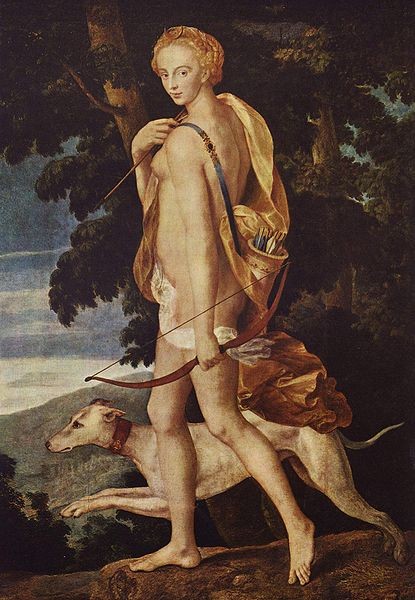
“Diana Huntress” by the School of Fontainebleau
“Diana Huntress” by the School of Fontainebleau is a mythical representation of Diane de Poitiers, the mistress of King Henry II, in the guise of the goddess Diana. The figure carries a bow and a quiver of arrows and is accompanied by a dog. In her hair is an ornament in the shape of a crescent moon, an attribute of the goddess.
This painting is one of many works by artists of the School of Fontainebleau depicting Diane de Poitiers, who was often personified as Diana. The School of Fontainbleau (c.1530 – c.1610) refers to two periods of artistic production in France during the late Renaissance centered on the Royal Palace of Fontainebleau.
The style of the School of Fontainebleau would continue to influence artists through the first decades of the 17th century. Then other artistic currents such as Rubens, Caravaggio, the Dutch, and Flemish naturalist schools soon eclipse them.
“Diana Huntress” by School of Fontainebleau
- Title: Diana Huntress
- Artist: School of Fontainebleau
- Created: 1550s
- Media: Oil on canvas
- Dimensions: 75.25 in x 52 in (191 cm x 132 cm),
- Type: Mythological Art
- Museum: Musée du Louvre
~~~
“Diana the Huntress” by Vincent Malo

“Diana the Huntress” by Vincent Malo
“Diana the Huntress” by Vincent Malo depicts Diana, who was originally considered to be a goddess of the wilderness and the hunt, a central sport in both Roman and Greek culture.
In the Hellenistic period, Diana came to be equally revered as a goddess of the civilized countryside. This painting captures her dual role as goddess of both civilization and the wild, and therefore the civilized countryside.
Vincent Malo (1585 – 1649) was a Flemish painter who, after training and working in Antwerp, was mainly active in Italy. Malo was a painter of genre scenes and religious and mythological subjects.
“Diana the Huntress” by Vincent Malo
- Title: Diana the Huntress
- Artist: Vincent Malo
- Created: second quarter of 17th century
- Media: Oil on canvas
- Dimensions: Height: 180 cm (70.8″); Width: 160 cm (62.9″)
- Type: Mythological Art
- Museum: National Museum, Warsaw
~~~
“Diana as Huntress” by Nicholas Stocade Van Helt

“Diana as Huntress” by Nicholas Stocade Van Helt
“Diana as Huntress” by Nicolaes de Helt Stockade depicts the goddess, who, according to the Greek legend of Artemis, her counterpart, was born on the island of Delos. Her parents were the gods Jupiter and Latona, and her twin brother was Apollo. She is considered a virgin goddess and protector of childbirth.
The Roman poet Nemesianus wrote a typical description of Diana:
“She carried a bow and a quiver full of golden arrows, wore a golden cloak, purple half-boots, and a belt with a jeweled buckle to hold her tunic together, and wore her hair gathered in a ribbon.”
Nicolaes van Helt Stockade (1614 – 1669) was a Dutch Golden Age painter. He became a master in the Antwerp Guild of Saint Luke in 1646 and worked on the city hall of Nijmegen and the Amsterdam City Hall.
“Diana as Huntress” by Nicholas Stocade Van Helt
- Title: Diana as Huntress
- Artist: Nicholas Stocade Van Helt
- Created: 1654
- Media: Oil on canvas
- Dimensions: w65.4 x h86 cm
- Type: Mythological Art
- Museum: Museum of Fine Arts, Houston
~~~
“Diana Reposing” by Paul-Jacques-Aimé Baudry

“Diana Reposing” by Paul-Jacques-Aimé Baudry
“Diana Reposing” by Paul-Jacques-Aimé Baudry depicts the nude goddess, identified by the crescent moon in her hair and the bow and quiver at her side. Baudry composition shows Dianna reclined on a blue drapery in front of a stag in a woodland setting.
In their worship of the goddess, the Greeks filled their temples with sculptures of the goddess. Many of the statues were adapted for use in the worship of Diana by the Romans, beginning around the 2nd century BCE. Diana was usually depicted for educated Romans in her Greek guise.
Diana was often shown accompanied by a deer, this was symbolic of her role as the patroness of hunting. The deer also a reference to the myth of Acteon, who saw her bathing naked. Diana punished him by transformed Acteon into a stag and set his hunting dogs to kill him.
Paul-Jacques-Aimé Baudry (1828 – 1886) was a French painter. The works that crowned Baudry’s reputation were his mural decorations, which show imagination and an artistic gift for color.
“Diana Reposing” by Paul-Jacques-Aimé Baudry
- Title: Diana Reposing
- Artist: Paul-Jacques-Aimé Baudry
- Created: 1859
- Media: Oil on mahogany wood
- Dimensions: H: 35.2 cm (13.8″); W: 59.5 cm (23.4″); D: 1.2 cm (0.5″)
- Type: Mythological Art
- Museum: Walters Art Museum
~~~
“Diana the Huntress” by Giampietrino
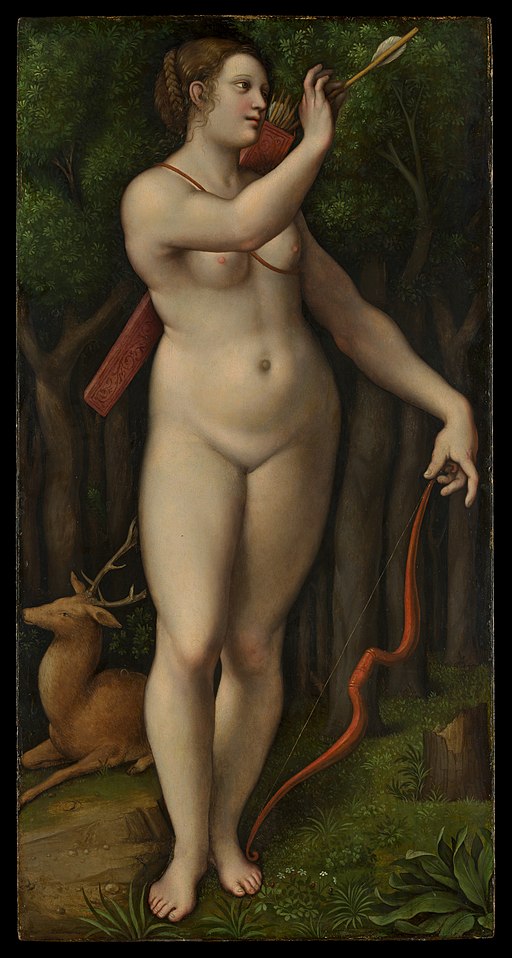
“Diana the Huntress” by Giampietrino
“Diana the Huntress” by Giampietrino depicts the goddess of the hunt drawing an arrow. Diana is portrayed before a dense bank of trees with a delicate deer beside her. The artist was a faithful Milanese pupil of Leonardo da Vinci and copied Leonardo’s so-called Standing Leda to show the Diana in a contrapposto stance, with one hip back and the opposite foot forward.
Giampietrino seems to have carved a niche for himself with the depiction of female heroines of mythology and Roman history. Inspired by Leonardo’s two “Leda and the Swan” compositions, which are both lost, the female figures are generally shown nude and, often, full length and set in a landscape.
Giampietrino or Giovanni Pietro Rizzoli (1495–1549), was a north Italian painter of the Lombard school and from Leonardo’s circle. Giampietrino was among the most faithful Milanese pupils of Leonardo da Vinci.
Giampietrino contributed to the distribution of the style of Leonardo da Vinci. He copied numerous masterpieces by Leonardo, as well as leaving behind various original compositions of his own. Many of his works are preserved in multiple versions of the same subject.
“Diana the Huntress” by Giampietrino
- Title: Diana the Huntress
- Artist: Giampietrino – Giovanni Pietro Rizzoli
- Created: 1526
- Media: Oil on wood
- Dimensions: 44 7/8 x 23 1/4 in. (114 x 59.1 cm)
- Type: Mythological Art
- Museum: Metropolitan Museum of Art
~~~
“Diana Huntress” by Bartolomeo Passerotti
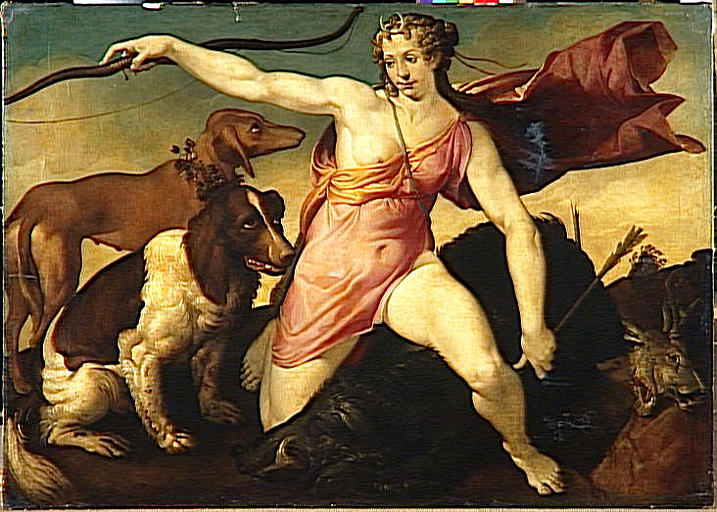
“Diana Huntress” by Bartolomeo Passerotti
“Diana Huntress” by Bartolomeo Passerotti depicts the goddess of the hunt, with all her traditional symbols for easy identification. In her hair, she wears an ornament in the shape of a crescent moon. She holds a bow as she leads her hunting dogs in the hunt.
Diana has killed a big black boar and is shown at the moment when she is about to withdraw her arrow from the creature. Another symbol used to identify Diana is a deer with has been added on the bottom right of the painting.
Bartolomeo Passarotti or Passerotti (1529 – 1592) was an Italian painter of the mannerist period, who worked mainly in his native Bologna. He influenced many Bolognese who would later play a role in the rise of the Baroque.
“Diane Huntress” by Bartolomeo Passerotti
- Title: Diane Huntress
- Artist: Bartolomeo Passerotti
- Created: Second half of the 16th century
- Media: Oil
- Type: Mythological Art
- Museum: Musée du Louvre
~~~
“Diana the Huntress” by Orazio Gentileschi
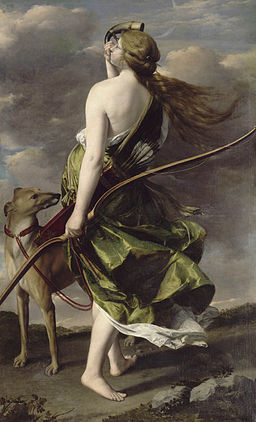
“Diana the Huntress” by Orazio Gentileschi
“Diana the Huntress” by Orazio Gentileschi depicts Diana, the goddess of the hunt and the moon from Roman mythology.
Diana is the only pagan goddess mentioned by name in the New Testament in Acts 19:27, in some translations by her Greek name “Artemis.” The part of Acts that references the pagan goddess has been called “The Riot in Ephesus”:
“There is danger not only that our business will fall into disrepute, but also that the temple of the great goddess Artemis (some translations use the name Diana) will be discredited and her majesty deposed—she who is worshiped by all the province of Asia and the whole world.”
When the men heard this, they were enraged and began shouting, “Great is Artemis of the Ephesians!” Soon the whole city was in disarray. They rushed together into the theatre, dragging with them Gaius and Aristarchus, Paul’s traveling companions from Macedonia.…”
As a result of her reference in the Bible, Diana later became associated with many folk beliefs involving goddess-like supernatural figures that Catholic clergy demonize. In the Middle Ages, legends of night-time processions of spirits led by a female figure are recorded in the church records of Italy, Germany, and France.
Orazio Lomi Gentileschi (1563–1639) was an Italian painter. After 1600, he came under the influence of the more naturalistic style of Caravaggio. He spent the last part of his life at the court of Charles I of England. He was the father of the painter Artemisia Gentileschi.
“Diana the Huntress” by Orazio Gentileschi
- Title: Diane the Huntress
- Français : Diane chasseresse.
- Artist: Orazio Gentileschi
- Created: Second quarter of the 17th century.
- Media: Oil on canvas
- Dimensions: Height: 215 cm (84.6″); Width: 135 cm (53.1″) .
- Type: Mythological Art
- Museum: Nantes Museum of Arts
~~~
“Diane the Huntress” by Guillaume Seignac

“Diane the Huntress” by Guillaume Seignac
“Diane the Huntress” by Guillaume Seignac is a more modern depiction of the goddess who is dressed in the classical “peplos” of ancient Greece. A peplos is a body-length garment that became the typical attire for women in ancient Greece by 500 BC.
The peplos was a long, tubular cloth with the top edge folded down about halfway so that what was the top of the tube was now draped below the waist, and the bottom of the tube was at the ankle. The garment was then gathered about the waist and the folded top edge pinned over the shoulders. The folded-down top of the tube provided the appearance of the second piece of clothing.
The Classical garment is represented in Greek vase painting, in the metopes of temples and on classical sculptures.
Guillaum Seignac (1870–1924) was a French academic painter. Much of Seignac’s work displayed classical themes and style, his use of diaphanous drapery covering a woman’s body is reminiscent of classical style, in particular the sculptor Phidias.
“Diane the Huntress” by Guillaume Seignac
- Title: Diane the Huntress
- Artist: Guillaume Seignac
- Created: early 1900s
- Media: Oil on canvas
- Type: Mythological Art
- Museum: Private collection
Take a Virtual Tour on the Art of Everything
- “The Fall of Icarus” in Art
- “Cupid and Psyche” in Art
- “Saint John the Baptist” in Art
- “Diana and Callisto” in Art
- “Leda and the Swan” in Art
- “Oedipus and the Sphinx” in Art
- “Achilles on Skyros” in Art
- The Cyclops Polyphemus in Art
- “Ulysses and the Sirens” in Art
- “Diana the Huntress” in Art
- “Venus and Adonis” in Art
- The Art of the Kiss
- The Art of War
- The Art of Philosophy
- The Art of Love
- Madonna and Child in Art
- The Art of Boxing
- Public Art
Diana Goddess
Greek Gods: Artemis
Artemis Goddess Of The Hunt & Moon – Greek Mythology Explained
~~~
“Artemis of the wilderness, the lady of wild beasts. Zeus has made you a lion among women and given you leave to kill any at your pleasure. You hunt down the ravening beasts in the mountains and deer of the wilds.”
– Homer, Iliad
~~~
Photo Credit 1) Giuseppe Cesari / Public domain; Guillaume Seignac / Public domain; Unknown author (School of Fontainebleau) / Public domain; Vincent Malo / Public domain; Museum of Fine Arts, Houston / Public domain; Anton Raphael Mengs / Public domain; Paul-Jacques-Aimé Baudry / Public domain; Giampietrino / Public domain; Bartolomeo Passarotti / Public domain; Orazio Gentileschi / Public domain
Popular this Week
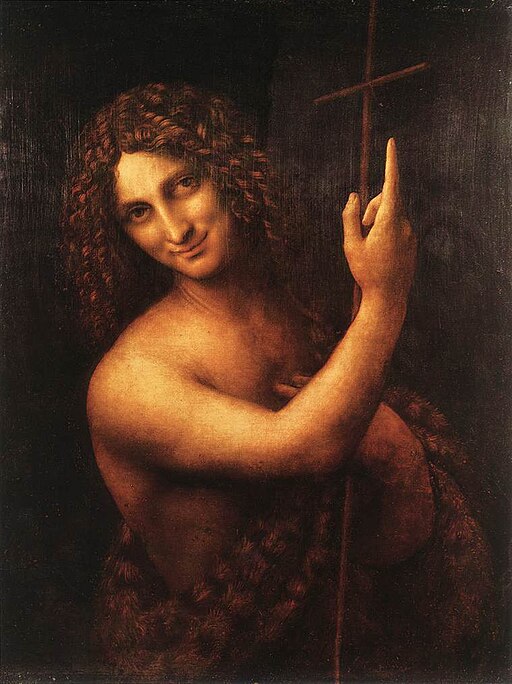





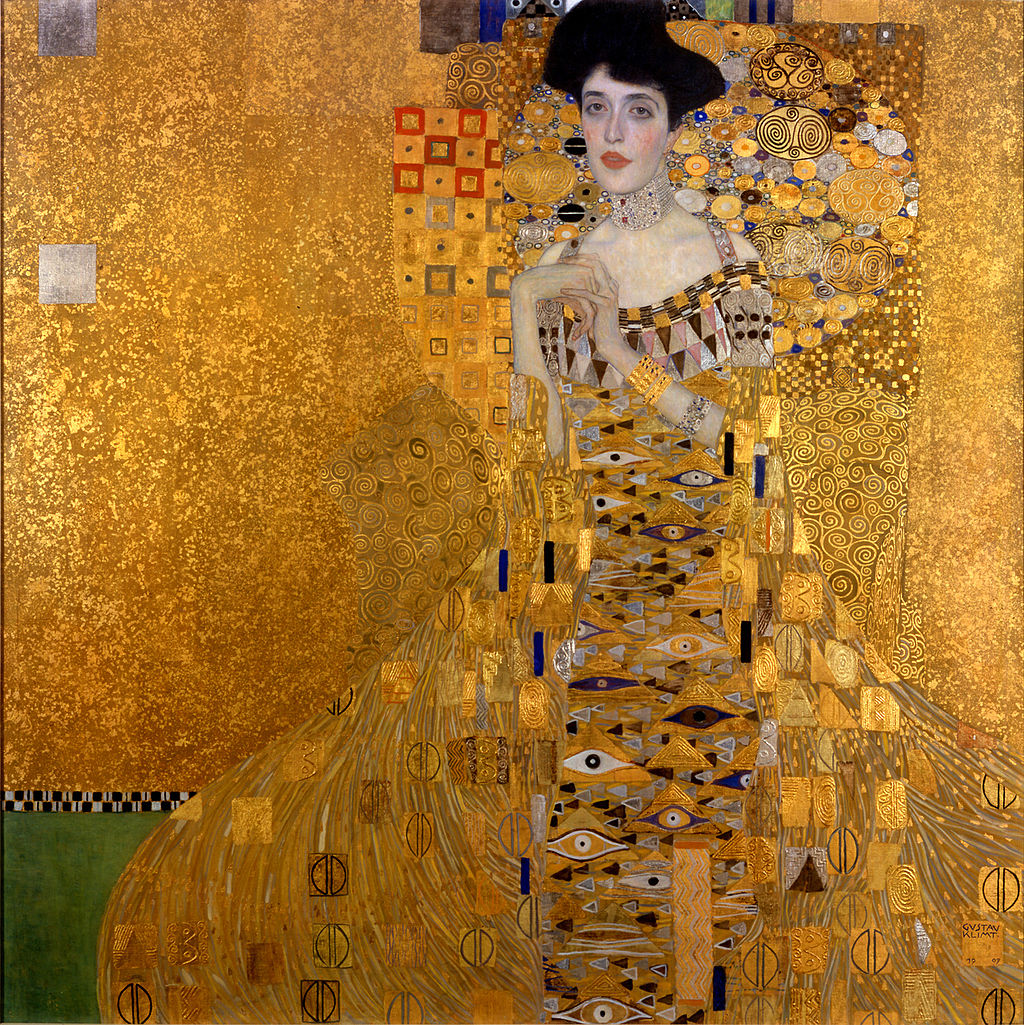

 Sponsor your Favorite Page
Sponsor your Favorite Page SEARCH Search for: Search Follow UsJoin – The JOM Membership Program
Sponsor a Masterpiece with YOUR NAME CHOICE for $5
Share this:
- Tweet
